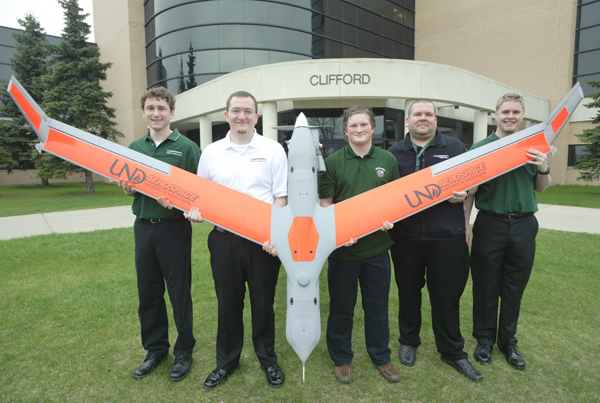
The first University of North Dakota students graduating with a BS in Aeronautics with a Major in Unmanned Aircraft Systems Operations. (Left to right); Adam Julson, Chris Burger, Brett Whalin, Jeremy Duke and Alex Gustafson stand with an UAS -Scan Eagle outside of Clifford Hall on camus. (Photo Credit: Jackie Lorentz)
Among the nearly 1,500 students who received degrees from the University of North Dakota during spring commencement on Saturday were the first graduates in the nation with degrees in unmanned aircraft systems operations.
“It’s truly the first and only kind of its major programme in the country at this point,” said Kent Lovelace, chair of the aviation department at the UND John D. Odegard School of Aerospace Sciences. “These are the first graduates from anywhere in the country with a degree in UAS operations.”
The five students eligible for graduation are Christopher Burger, Ritzville, Wash.; Jeremy Duke, Everett, Wash.; Adam Julson, Flandreau, S.D.; Alexander Gustafson, Vashon Island, Wash.; and Brett Whalin, Rapid City, S.D. The commencement ceremony was held in the Alerus Center at Grand Forks.
“Unmanned aircraft are having a profound impact on aerospace,” said Bruce Smith, dean of UND Aerospace. “We’re on the leading edge of UAS development. We now have 44 students signed up as majors and 78 students signed up for our UAS introductory course.”
Julson is excited about the opportunity to be part of an emerging aspect of aviation in which the sky is literally the limit. “What attracted me is that it’s the next big thing,” he said. “You’re on the forefront of the unmanned portion of aviation.”
For Duke, who worked for 10 years in the auto body industry before coming to UND, the attraction was the potential to apply UAS technology to weather research, which is the career direction he hopes to pursue. “I flew weather modification missions for a summer and could see the application,” he said.
All the UAS majors are finding great interest from potential employers, and some have already lined up jobs. The field is expected to explode when the Federal Aviation Administration (FAA) opens airspace to civilian applications. “We could see it open up in the next few months for law enforcement agencies,” said Mark Hastings, UAS chief pilot. “It probably won’t be until 2015 that we see it opening up to commercial applications, such as patrolling oil pipelines.”
Gustafson, who’s been interviewed for two jobs, said, “It’s a huge honour and privilege to be among the first graduates. Most companies are excited to find out that there are students coming out of college with degrees in UAS. There are a lot of jobs now, and there will be even more when the airspace opens up.”
First offered in 2009 fall semester, the Bachelor’s of Science degree aeronautics with a major in unmanned aircraft systems operations is built on the school’s commercial aviation programme. It includes courses in the systems of unmanned aircraft, UAS ground systems, UAS communications and telemetry, and UAS remote sensing. In addition, the major curriculum includes aviation safety, human factors, and crew resource management related to unmanned aircraft operations.
“We spent a lot of time and effort putting this programme together because there was no model for it,” said Ben Trapnell, associate professor of aviation. “We had to bridge the gap between engineers and pilots because our hope is that our graduates from this programme will become the leaders in an emerging civil UAS industry. They need to have a broad perspective and the ability to expand the base of knowledge we provide.”
Burger started at UND as a commercial aviation major, but jumped at the opportunity to be in the first class of students to graduate with a degree in UAS operations. “I figured that UAS was definitely going to be a major portion of the aviation industry in the future,” he explained. “Automation is the direction everything is moving. Getting in at the beginning seemed like a great opportunity.”
UND collaborated with Corsair Engineering to provide training to students pursuing their UAS majors. They used the ScanEagle UAS simulator to learn mission-related UAS employment and operational techniques. The simulator was created jointly by Corsair and the aircraft’s manufacturer to accurately represent the experience of flying the real aircraft.
“The more you understand the system you’re operating, the better pilot you can be,” Hastings said. “The more you understand the payload and the sensors, the better operator you can be. They will be the future leaders of the industry. Understanding the development and the operations side puts them in a really good place.”
The first group of eight students completed academics and flight training March 4. During the eight week-long sessions, students spent three hours per day, five days a week in the ScanEagle simulator, progressing from basic flight operations to advanced sensor techniques and emergency procedures, and finally to mission employment scenarios. “They don’t just learn how to operate an unmanned aerial vehicle, but also to manage a UAS programme and make recommendations about what type of vehicle makes the most sense,” Lovelace said. “The UAS industry is really in its infancy. These graduates will help take it to the next level.”
Recalling his decision to be one of the first to join UND’s UAS operations programme, Whalin said, “I feel like it was a great opportunity to get in on the bottom floor of a growing field. It’s been a challenge and a great an opportunity.”
Source: University of North Dakota
